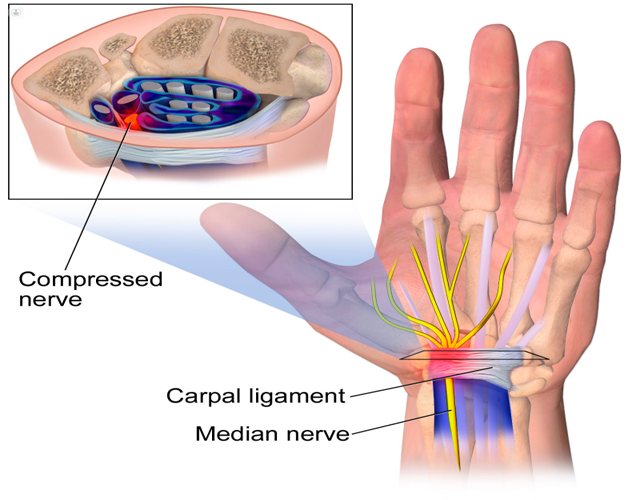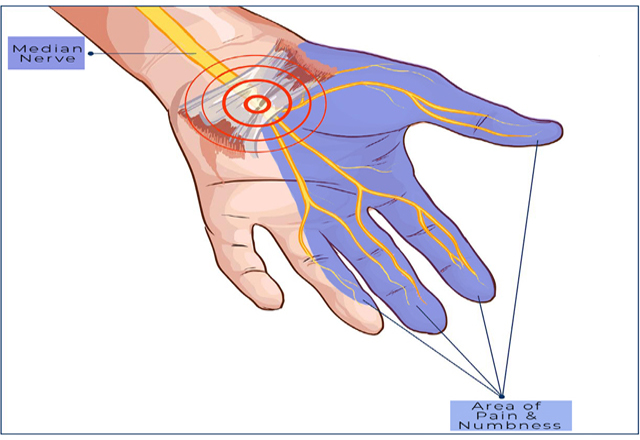




Carpal tunnel syndrome is a hand and arm condition that causes numbness, tingling and other symptoms. Carpal tunnel syndrome is caused by a pinched nerve in your wrist. Bound by bones and ligaments, the carpal tunnel is a narrow passageway located on the palm side of your wrist. This tunnel protects a main nerve (median nerve) to your hand and the nine tendons that bend your fingers. Compression of the nerve produces the numbness, tingling and, eventually, hand weakness that characterize carpal tunnel syndrome. Fortunately, for most people who develop carpal tunnel syndrome, proper treatment usually can relieve the tingling and numbness and restore wrist and hand function. Carpal tunnel syndrome usually starts gradually with numbness or tingling in your thumb, index and middle fingers that comes and goes. This may be associated with discomfort in your wrist and hand.

Common carpal tunnel syndrome symptoms include:
You may experience tingling and numbness in your fingers or hand, especially your thumb and index, middle or ring fingers, but not your little finger. This sensation often occurs while holding a steering wheel, phone or newspaper or, commonly, waking you from sleeping. The sensation may extend from your wrist up your arm. Many people "shake out" their hands to try to relieve their symptoms. As the disorder progresses, the numb feeling may become constant.
You may experience weakness in your hand and a tendency to drop objects. This may be due to the numbness in your hand or weakness of the thumb's pinching muscles, which are controlled by the median nerve.
Athletes are not the only people who get tennis elbow. Many people with tennis elbow participate in work or recreational activities that require repetitive and vigorous use of the forearm muscle. Painters, plumbers, and carpenters are particularly prone to developing tennis elbow. Studies have shown that auto workers, cooks, and even butchers get tennis elbow more often than the rest of the population. It is thought that the repetition and weight lifting required in these occupations leads to injury.
A number of factors have been associated with carpal tunnel syndrome. Although by themselves they don't cause carpal tunnel syndrome, they may increase your chances of developing or aggravating median nerve damage. These include:

A wrist fracture or dislocation that alters the space within the carpal tunnel can create extraneous pressure on the median nerve. People with smaller carpal tunnels may be more likely to have carpal tunnel syndrome.
Carpal tunnel syndrome is generally more common in women. This may be because the carpal tunnel area is relatively smaller than in men, and there may be less room for error. Women who have carpal tunnel syndrome may also have smaller carpal tunnels than women who don't have the condition.
Some chronic illnesses, such as diabetes, increase your risk of nerve damage, including damage to your median nerve.
Illnesses that are characterized by inflammation, such as rheumatoid arthritis, can affect the tendons in your wrist, exerting pressure on your median nerve.
Fluid retention, common during pregnancy or menopause, may increase the pressure within your carpal tunnel, irritating the median nerve. Carpal tunnel syndrome associated with pregnancy generally resolves on its own after pregnancy.
Certain conditions, such as menopause, obesity, thyroid disorders and kidney failure, may increase your chances of carpal tunnel syndrome.
It's possible that working with vibrating tools or on an assembly line that requires prolonged or repetitive flexing of the wrist may create harmful pressure on the median nerve or worsen existing nerve damage.

Your doctor may conduct one or more of the following tests to determine whether you have carpal tunnel syndrome:
Your doctor will review your symptoms. The pattern of your signs and symptoms may offer clues to their cause. For example, because the median nerve doesn't provide sensation to your little finger, symptoms in that finger may indicate a problem other than carpal tunnel syndrome. Another clue is the timing of the symptoms. Usual times when you experience symptoms due to carpal tunnel syndrome include while holding a phone or a newspaper, gripping a steering wheel, or waking up during the night.
Your doctor will conduct a physical examination. He or she will test the feeling in your fingers and the strength of the muscles in your hand. Pressure on the median nerve at the wrist, produced by bending the wrist, tapping on the nerve or simply pressing on the nerve, can bring on the symptoms in many people.
Electromyography measures the tiny electrical discharges produced in muscles. During this test, your doctor inserts a thin-needle electrode into specific muscles. The test evaluates the electrical activity of your muscles when they contract and when they're at rest. This test can determine if muscle damage has occurred and also may be used to rule out other conditions.
In a variation of electromyography, two electrodes are taped to your skin. A small shock is passed through the median nerve to see if electrical impulses are slowed in the carpal tunnel. This test may be used to diagnose your condition and rule out other conditions. Your doctor may recommend that you see a doctor trained in brain and nervous system conditions (neurologist), brain and nervous system surgery (neurosurgeon), hand surgery, rheumatoid arthritis, or other areas if your signs or symptoms indicate other medical disorders or need additional treatment.

Carpal tunnel syndrome should be treated as early as possible after you begin to experience symptoms.
If the condition is diagnosed early, nonsurgical methods may help improve carpal tunnel syndrome. Methods may include:
A splint that holds your wrist still while you sleep can help relieve nighttime symptoms of tingling and numbness. Nocturnal splinting may be a good option if you're pregnant and have carpal tunnel syndrome.
NSAIDs may help relieve pain from carpal tunnel syndrome in the short term
Your doctor may inject your carpal tunnel with a corticosteroid such as cortisone to relieve your pain. Corticosteroids decrease inflammation and swelling, which relieves pressure on the median nerve. If carpal tunnel syndrome results from an inflammatory arthritis, such as rheumatoid arthritis, then treating the arthritis may reduce symptoms of carpal tunnel syndrome, but this hasn't been proved.
If your symptoms are severe or persist after trying nonsurgical therapy, surgery may be the most appropriate option. The goal of carpal tunnel surgery is to relieve pressure on your median nerve by cutting the sheath pressing on the nerve. In general, your doctor will encourage you to use your hand after surgery, gradually working back to normal use of your hand while avoiding forceful hand motions or extreme wrist positions. Soreness or weakness may take from several weeks to a few months to resolve after surgery. If your symptoms were very severe before surgery, symptoms may not go away completely after surgery.
Website Designed By: Quick n Host